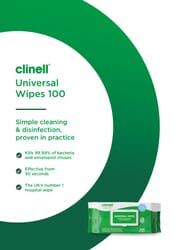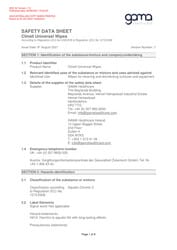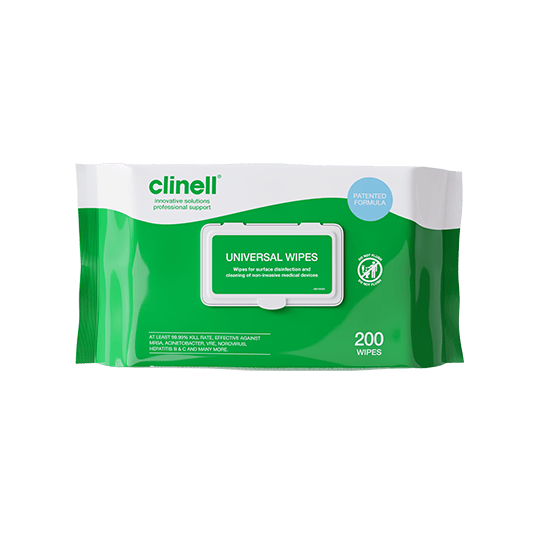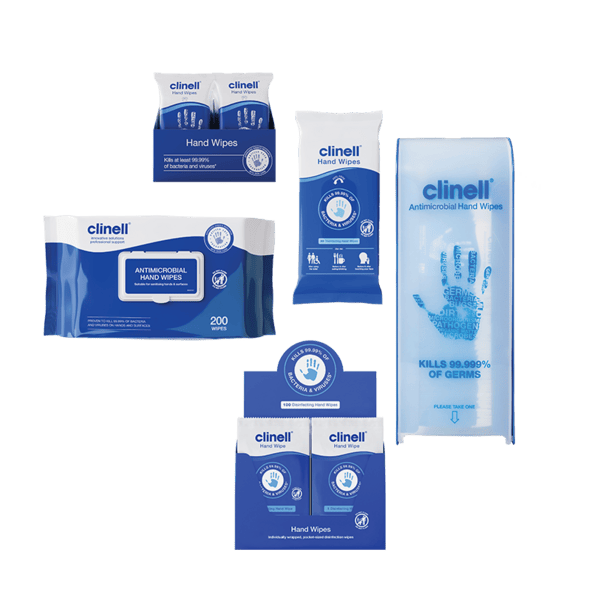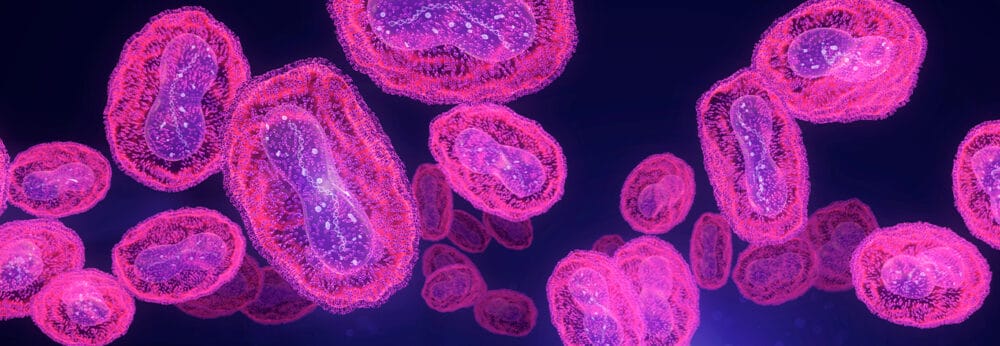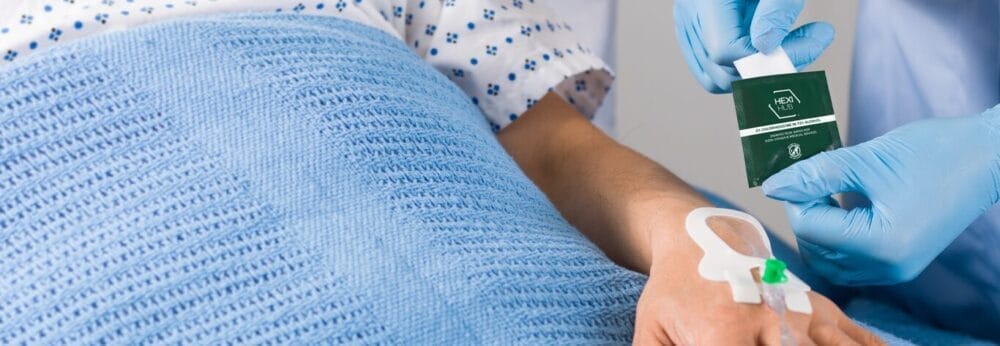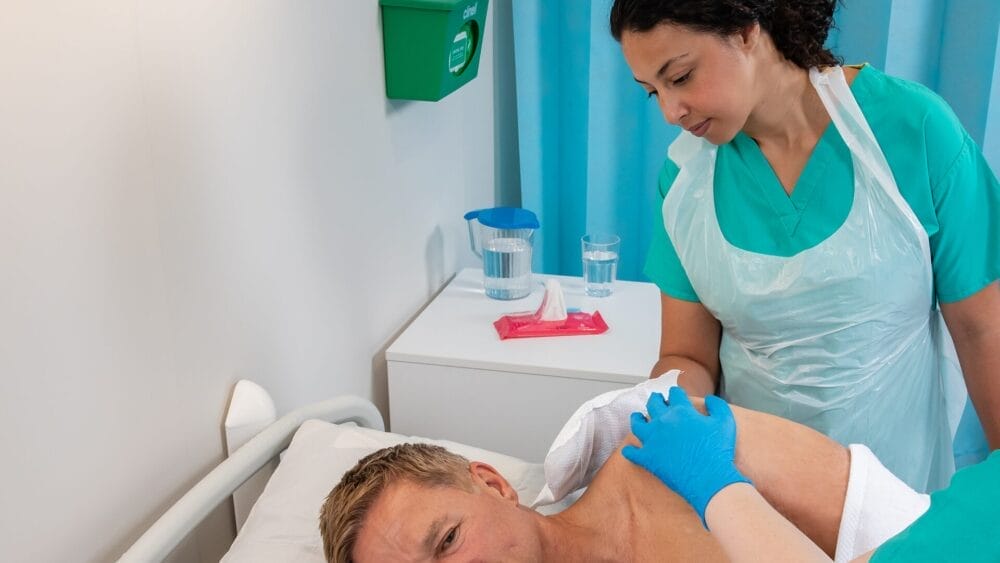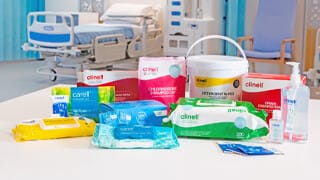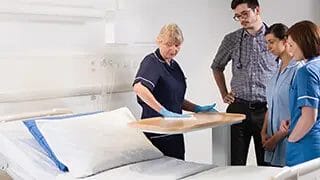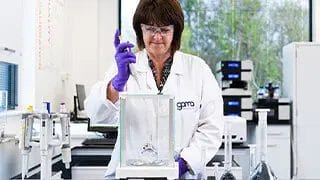Universal Surface Wipes 100
The NHS' number 1 disinfectant wipe, used in 9 out of 10 NHS hospitals, now available for homes, schools and businesses. Kills 99.99% of bacteria and viruses from 20 seconds.
Clinell Universal Surface Wipes kill up to 10x more bacteria and viruses than standard household disinfectants. Unlike pure disinfectant wipes, Clinell Universal Surface Wipes clean whilst they disinfect, helping remove dirt and soiling whilst boosting their germ-killing power. They get to get to work right away, proving effective from only 20 seconds. Despite all that cleaning and killing power, they're skin-friendly, dermatologically tested and kind to surfaces.
Product code: BCW100
Effective against the COVID-19 virus in 30 seconds.
| Effective Against | Test | Kill Time |
|---|---|---|
| Bacteria | ||
| Enterococcus hirae | EN 13727 EN 16615 |
30 sec 30 sec |
| Escherichia coli K12 | EN 13727 EN 1500 |
30 sec 30 sec |
| Pseudomonas aeruginosa | EN 13727 EN 16615 |
30 sec 30 sec |
| Staphylococcus aureus | EN 13727 EN 16615 |
30 sec 30 sec |
| Stenotrophomonas maltophilia | EN 13727 | 30 sec |
| Viruses | ||
| Adenovirus | EN 14476 | 30 sec |
| Enterovirus 71 | EN 14476 | 2 min |
| Norovirus | EN 14476 | 30 sec |
| Vaccinia | EN 14476 | 30 sec |
| Yeast | ||
| Candida albicans | EN 13624 EN 16615 |
30 sec 30 sec |
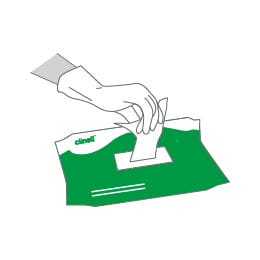
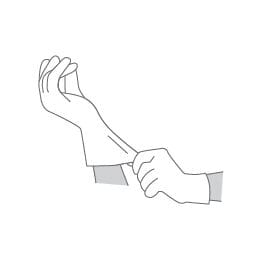
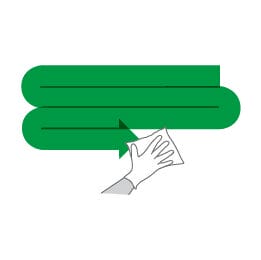
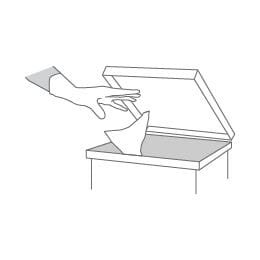
Are Clinell products effective against coronavirus?
The Clinell Universal Range, Clinell Peracetic Wipes, and Clinell Clorox Wipes have all been tested against strains of coronavirus and proven effective. Find out more here.
Have Clinell Universal Wipes been tested against COVID-19?
Clinell Universal Wipes have been proven effective against the exact strain of coronavirus that causes COVID-19 (SARS-CoV-2) in 30 seconds. They've been tested according to the EN14476 test method by an accredited, third-party laboratory.
Are Clinell Universal Wipes effective against the new UK and South African variants of coronavirus?
Yes. The changes in the new variants are very small mutations in their surface proteins. Whilst that has a big impact on how they affect the human body, it doesn’t give them increased resistance to disinfectants. Clinell Universal Wipes kill the coronavirus that causes COVID-19 in 30 seconds on surfaces.
Do Clinell Universal Wipes comply with UK national guidance about COVID-19?
UK national guidance for healthcare professionals specifically mentions chlorine as a disinfectant. This is because chlorine has long been seen as the 'de facto' disinfectant within UK healthcare. The guidance recommends using alternative disinfectants if they are agreed with the local Infection Prevention & Control (IPC) team and proven effective against enveloped viruses. Clinell Universal Wipes are effective against enveloped viruses according to EN14476. In addition, Clinell Universal Wipes are proven effective against the exact coronavirus that causes COVID-19 (SARS-CoV-2) in 30 seconds, according to EN14476. As long as they are agreed with your local IPC team, Clinell Universal Wipes are perfectly compliant with UK national guidance.
Why does it have a single use symbol on a pack of multiple wipes?
Each individual wipe is single use. This prevents the transfer of pathogens between surfaces or from one medical device to another.
Why is the product referred to as a Universal Wipe?
The wipes function as both disinfectant and detergent. They can also be used on all surfaces and all ward-based equipment.
What different formats are available for this product?
A variety of formats are available: Clinell Universal Buckets 225 (CWBUC225), Clinell Universal Bucket Refills 225 (CWBUC225R), Clinell Universal Clip Packs 50 (CWCP50), Clinell Universal Spray 60ml (CDS60), Clinell Universal Spray 500ml (CDS500), Clinell Universal Spray 750ml (CDS750), Clinell Universal Tubs 100 (CWTUB100), Clinell Universal Tub refills 100 (CWTUB100R), Clinell Universal Wipes 200 (CW200), Clinell Universal Wipes 40 (CW40) and Clinell Universal Wipe Adhesive Back 50 (CWAB50).
Why is it important to clean in addition to disinfecting?
Dirt creates a barrier between a surface and the disinfectant on the wipe therefore prevents the surface from being disinfected. Clinell Universal Wipes are designed to remove both dirt and disinfect at the same time meaning detergent and disinfectant wipes no longer need to be bought as two separate products.
What are the active ingredients in Clinell Universal Wipes?
The formulation in Clinell Universal Wipes is a patented, antimicrobial solution developed by GAMA's Research & Development Department. It contains multiple different biocides including two quaternary ammonium compounds and one polymeric biguanide designed to work synergistically. The effectiveness of the biocides is increased by many multiples when they are used together. This, in turn, ensures that the wipe has wide antimicrobial activity and a high kill count. In addition, the wipe contains surfactant (to act as a detergent) and a chelating agent.
Does using disinfectants increase the chance of resistance occurring with pathogens?
No, there is no risk of resistance occurring due to long-term use. This is because Universal delivers a high concentration of multiple different biocides each of which uses a differing mechanism of action, preventing resistance.
What does the term "contact time" mean?
"Contact time" is the time required for the disinfectant to act on pathogens. Essentially: how long it takes for the disinfectant to work. With liquid disinfectants, the contact time requires the disinfectant to remain wet on the surface in order for it to work effectively. The contact time can vary depending on the micro-organisms involved.
Why is the kill count important to know?
Apart from how fast it takes a disinfectant to work (i.e. contact time), it is also important to determine how many of a particular microorganism have been killed. A fast contact time would count for nothing if it allowed the majority of the microorganisms to remain active. This reduction in microorganisms or “kill count” is expressed in a log form. Put simply, the log number is the number of 9s expressed in a percentage reduction. For example: 2 log reduction is 99%, 4 log reduction is 99.99% and so on. Clinell Universal Wipes have demonstrated a 5 log kill count (99.999%) for most pathogens in the contact time specified.
Does the mechanical action of the wipe play an important part in the disinfection process?
The mechanical action of wiping removes soil and bioburden allowing the disinfectant to reach the surface and kill any remaining microorganisms directly. The bioburden that remains on the wipe is killed by the disinfectant that remains on the wipe.
Does the wipe retain some of the disinfectant?
Generally, wipe materials contain certain molecules that can hold and lock the wipe formulation into the wipe itself, preventing release. In other words, the disinfectant liquid that is put into a wipe is not the same as when extracted off a wipe. Therefore, testing must be carried out on the run off from the wipe rather than the formulation itself. GAMA Healthcare is one of the very few companies to ensure that the accredited laboratories who complete our independent testing do so on the run off from the wipes.
Where can Universal Wipes be used?
Universal Wipes are safe to be used on all surfaces. They will not damage rubbers, plastics or metals. Though alcohol-based wipes tend to damage materials after prolonged use, our patented, pH neutral formula ensures that this will not occur with Clinell Universal Wipes. Alongside surfaces, Universal Wipes can be used on all non-invasive medical devices. If you are unsure about whether the wipes are suitable to use on a particular object or surface please call a member of our sales team, who will be happy to assist. Always follow medical equipment manufacturer's cleaning procedures and guidelines.
What products do these wipes replace?
Universal Wipes are able to replace all detergent and disinfectant surface wipes (except for Peracetic Acid Wipes) and by doing so will help standardise wipe usage in a hospital, saving time, money and preventing confusion about the type of wipe required for each cleaning task. They are also able to replace medical device wipes (for use on non-invasive medical devices).
Where was the testing conducted for this wipe?
The tests mentioned have been conducted at various UK and European university accredited laboratories, according to test methods outlined by the European Union. All results are validated.
What are the wall-mounted dispensers?
These are colour-coded, plastic or wire dispensers that can be attached to hospital walls and are designed to hold the large flow wrap packs, tubs and buckets of Clinell Universal Wipes. Wall-mounted dispensers are available free-of-charge to all NHS hospitals in the UK. Installation (arranged through the GAMA Healthcare Sales Team) is also free of charge. Extra dispensers can be ordered directly through GAMA Healthcare as part of our comprehensive customer support package.
Are there any special disposal requirements?
Used wipes should be disposed of in the clinical waste bin as per your infection control policy. Maceratable Wipes can be disposed of in a macerator.
How would you summarise the benefits of Clinell Universal Wipes?
As the name suggests, Clinell Universal Wipes have a wide range of applications. Not only are they a single-step detergent and disinfectant wipe but they are suitable for all ward-based surfaces and all non-invasive medical devices. This allows hospitals to replace multiple products, saving money and simplifing their infection prevention policies. The wipes have a broad range of antimicrobial activity and are able to kill many pathogens within a very fast contact time and with a very high kill count. The efficacy of the wipes is backed-up by an extensive data package. Finally, purchases of Clinell Universal Wipes come with a fantastic customer support package including: custom-made posters and patient information leaflets; free wall-mounted dispensers (installed free-of-charge); comprehensive ward-based training by experienced infection control trainers; and a tablet-based training package.
Recommended for you
Latest
GAMA Healthcare expands Rediroom fleet with additional order for Midlands Trust
GAMA Healthcare has secured an order for 8 more Redirooms,…
News from the front line: GAMA Healthcare partners with leading Midlands Trust to enhance air quality across two sites
GAMA Healthcare is pleased to announce a significant investment from…
Celebrating 20 Years of GAMA Healthcare: Our Story
This month, GAMA Healthcare celebrates 20 years of helping prevent…
Norovirus: Understanding its transmission and prevention in the UK
Introduction Norovirus is recognised as the leading cause of viral gastroenteritis…

